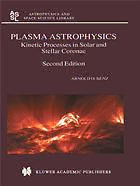
Plasma astrophysics : kinetic processes in solar and stellar coronae PDF
Preview Plasma astrophysics : kinetic processes in solar and stellar coronae
PLASMA ASTROPHYSICS ASTROPHYSICS AND SPACE SCIENCE LIBRARY VOLUME 279 EDITORIAL BOARD Chairman W.B. BURTON, National Radio Astronomy Observatory, Charlottesville, Virginia, U.S.A. ([email protected]); University of Leiden, The Netherlands ([email protected]) Executive Committee J. M. E. KUIJPERS, Faculty of Science, Nijmegen, The Netherlands E. P. J. VAN DEN HEUVEL, Astronomical Institute, University of Amsterdam, The Netherlands H. VAN DER LAAN, Astronomical Institute, University of Utrecht, The Netherlands MEMBERS I. APPENZELLER, Landessternwarte Heidelberg-Königstuhl, Germany J. N. BAHCALL, The Institute for Advanced Study, Princeton, U.S.A. F. BERTOLA, Universitá di Padova, Italy J. P. CASSINELLI, University of Wisconsin, Madison, U.S.A. C. J. CESARSKY, Centre d'Etudes de Saclay, Gif-sur-Yvette Cedex, France O. ENGVOLD, Institute of Theoretical Astrophysics, University of Oslo, Norway R. McCRAY, University of Colorado, JILA, Boulder, U.S.A. P. G. MURDIN, Institute of Astronomy, Cambridge, U.K. F. PACINI, Istituto Astronomia Arcetri, Firenze, Italy V. RADHAKRISHNAN, Raman Research Institute, Bangalore, India K. SATO, School of Science, The University of Tokyo, Japan F. H. SHU, University of California, Berkeley, U.S.A. B. V. SOMOV, Astronomical Institute, Moscow State University, Russia R. A. SUNYAEV, Space Research Institute, Moscow, Russia Y. TANAKA, Institute of Space & Astronautical Science, Kanagawa, Japan S. TREMAINE, CITA, Princeton University, U.S.A. N. O. WEISS, University of Cambridge, U.K. PLASMA ASTROPHYSICS Kinetic Processes in Solar and Stellar Coronae SECOND EDITION by ARNOLD O. BENZ Institute of Astronomy, ETH Zürich, Switzerland KLUWER ACADEMIC PUBLISHERS NEW YORK, BOSTON, DORDRECHT, LONDON, MOSCOW eBookISBN: 0-306-47719-X Print ISBN: 1-4020-0695-0 ©2002 Kluwer Academic Publishers NewYork, Boston, Dordrecht, London, Moscow Print ©2002 Kluwer Academic Publishers Dordrecht All rights reserved No part of this eBook maybe reproducedor transmitted inanyform or byanymeans,electronic, mechanical, recording, or otherwise, without written consent from the Publisher Created in the United States of America Visit Kluwer Online at: http://kluweronline.com and Kluwer's eBookstore at: http://ebooks.kluweronline.com It is through wonder that men now begin and originally began science; wondering in the first place at obvious perplexities, and then by gradual progression raising questions about the greater matters too, e.g. about the changes of the Moon and of the Sun, about the stars and about the origin of the universe. Aristotle 384 - 322 B.C. This page intentionally left blank CONTENTS PREFACE xv CHAPTER 1. INTRODUCTION 1 1.1. The Solar Corona 2 1.1.1. Brief Overview of the Sun 2 1.1.2. Optical Observations of the Corona 4 1.1.3. Soft X-Rays and EUV Lines 4 1.1.4. Thermal Radio Emissions 5 1.2. Dynamic Processes 7 1.2.1. Processes in the Upper Corona 7 1.2.2. Processes in the Lower Corona 7 1.2.3. Solar Flares 8 1.2.4. OtherDynamicProcesses 9 1.3. Stellar Coronae 11 1.3.1. Soft X-Ray Emission 11 1.3.2. Stellar Flares 12 1.3.3. Quiescent Radio Emission 14 1.4. FundamentalEquations 15 1.4.1. Magnetohydrodynamic Approach 17 1.4.2. Kinetic Approach 18 FurtherReading and References 21 CHAPTER 2. BASIC CONCEPTS 22 2.1. Single Particle Orbit 22 2.1.1. Homogeneous Magnetic Field 22 2.1.2. Inhomogeneous Magnetic Field 25 2.1.3. Conservation of the Magnetic Moment 26 2.1.4. ParticleDrifts 27 A. Electric Field 29 B. Gravitational Field 29 C. Curved Field Lines 29 2.2. Particle Trapping in Magnetic Fields 30 2.3. Generation of Beams 32 2.4. Debye Shielding 35 2.5. Charge Oscillations and the Plasma Frequency 38 2.6. Collisions 40 vii viii CONTENTS 2.6.1. Particle Encounters in a Plasma 40 2.6.2. Fokker-Planck Method 42 2.6.3. Collision Times 43 A. Angular Deflection 43 B. Energy Exchange 45 C. Momentum Loss 46 D. Energy Loss 46 E. Discussion 48 F. Thermal Collision Times 49 Exercises 49 Further Reading and References 50 CHAPTER 3. MAGNETOHYDRODYNAMICS 51 3.1. Basic Statistics 51 3.1.1. BoltzmannEquation 51 3.1.2. Velocity Moments of the Boltzmann Equation 52 A. Conservation of Particles 53 B. Conservation of Momentum 53 C. Conservation of Energy 54 3.1.3. Elementary Magnetohydrodynamics (MHD) 55 A. MHD Equations and Approximations 56 B. Electric Fields 58 C. MHD Properties 58 3.2. MHD Waves 61 3.2.1. Linearization 61 3.2.2. Dispersion Relation and Polarization (Parallel Propagation) 62 3.2.3. Perpendicular Propagation 65 3.2.4. General Case 66 Exercises 67 Further Reading and References 68 CHAPTER 4. WAVES IN A COLD, COLLISIONLESS PLASMA 69 4.1. Approximations and Assumptions 69 4.2. Cold Plasma Modes 71 4.2.1. Linearization 71 4.2.2. Ohm’s Law 73 4.2.3. Dielectric Tensor 74 4.2.4. Dispersion Relation 75 4.3. Parallel Waves 76 4.3.1. Electrostatic Waves 76 4.3.2. Electromagnetic Waves 77 4.3.3. Dispersion Relations of the L and R Waves 78 4.3.4. Resonances at the Gyrofrequencies 79 4.3.5. Cutoffs Near 80 CONTENTS ix 4.4. Perpendicular Propagation 81 4.4.1. Electrostatic Waves 81 4.4.2. Electromagnetic Waves 82 4.5. Oblique Propagation and Overview 83 4.6. Beam Mode 85 Exercises 87 Further Reading and References 88 CHAPTER 5. KINETIC PLASMA AND PARTICLE BEAMS 89 5.1. Radio Observations of Solar Electron Beams 89 5.1.1. Radio Instruments 92 5.1.2. Type III Radio Bursts 93 5.2. Waves and Instability in Kinetic Plasmas 94 5.2.1. Singularities 98 5.2.2. Dispersion Relation 100 A. Principal Part 100 B. Singular Point 100 5.2.3. Landau Damping 101 5.2.4. Bump-on-Tail Instability 102 5.2.5. Resonance 103 5.2.6. Ion Acoustic Waves 104 5.2.7. Thermal Level of Waves 106 5.3. Plasma Waves in the Solar Corona 107 5.3.1. Plasma Density 107 5.3.2. Drift 108 5.3.3. Field Geometry 109 A. U-Bursts 109 B. Magnetic Field Configuration Near Acceleration 111 C. Interplanetary Space 111 5.3.4. Decay Time 112 5.3.5. Other Radio Wave Emitting Beams 113 Exercises 113 Further Reading and References 114 CHAPTER 6. ASTROPHYSICAL ELECTRON BEAMS 115 6.1. The Beam-Plasma System 115 6.1.1. Magnetically Driven Return Current 116 6.1.2. Electrostatic Return Current 119 6.2. Non-Linear Evolution and Saturation 120 6.2.1. Quasi-Linear Diffusion 122 6.2.2. Strong Turbulence 124 6.2.3. Deflection of Electrostatic Waves 126 6.2.4. Summary 127
